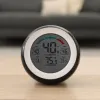As of July 2020, Atlanta is in the thick of the COVID-19 outbreak. While it’s almost impossible to eliminate your risk of contracting the virus, there are things we can do to reduce our risk of getting it.
Wearing face masks, staying six feet from others, minimizing time spent in public… we all know about those guidelines. And we should follow them.
But are there any HVAC modifications you could make to reduce your risk at home? Well, yes. There are some.
Disclaimer: We are not medical or public health professionals.
As such, anything we say here should be understood as only coming from an HVAC expert. We’ll cite guidance from the medical and public health authorities in making our suggestions, but please know that nothing in this article rises to the level of medical advice.
Also – and this is super important – we’re not claiming that any HVAC updates you perform will prevent you from contracting COVID-19. You might still get it. The best ways to minimize the spread of this disease, per health authorities, are to practice social distancing, wear a face covering in public, and wash your hands a lot.
Ok, now that that’s out of the way…
Better ventilation may reduce your risk of coronavirus exposure indoors.
In the Centers for Disease Control’s (CDC’s) official COVID-19 Workplace and School Guidance (PDF) document, families are encouraged to “increase ventilation by opening windows or adjusting air conditioning.”
We’re not sure what “adjusting air conditioning” means. If they mean running the AC more often (or maybe just the fan, which can have negative consequences), that will increase air filtration, but not ventilation. Maybe they meant adding a ventilation damper? If they did, they could have said so.
As for opening windows, that increases ventilation. However, it might not be the type of ventilation you want – especially during our hot, muggy summers.
The bottom line is that the CDC recommends better ventilation in your home as a measure to reduce your risk of coronavirus exposure. This makes sense. In an airtight home with no ventilation, the same air just gets recirculated all the time with no dilution. If someone with COVID came into your home, even if just for a few minutes, their germs would circulate throughout your indoor air for an indefinite amount of time. That’s not ideal.
So, what are the best ways to improve ventilation in your home? Here are our favorites
Energy recovery ventilators (ERVs)
If you’re looking for a straight-up mechanical ventilation system that provides regular air exchanges without increasing humidity to uncomfortable levels, look no further than an ERV.
ERVs and HRVs connect to your HVAC system. They can be set up to provide a certain amount of ventilation depending on the needs of your home and your own personal indoor air quality/comfort concerns.
In our climate zone, you’ll want an ERV, not an HRV. That’s because, in addition to ventilation, the ERV also removes some moisture from the incoming air during the summer. You get ventilation without all the mugginess of an open window!
Note that an ERV is not a dehumidifier. The air coming into your home will be less humid than the outdoor air, but it will still contain moisture. In the Atlanta region, it’s a good idea to pair an ERV with a whole-house dehumidifier.
ERVs provide balanced ventilation. This means they’re set up by default to expel and introduce an equal amount of air from your home. That way, you get fresh air without pressurizing the space.
Ventilating dehumidifiers
You’ve probably heard of whole-house dehumidifiers that connect to your ductwork and remove moisture from the air. Well, these units can almost always be set up to provide fresh air in addition to dehumidification.
During the whole-house dehumidifier installation, an additional duct brings outdoor air into the dehumidifier, which filters the air and removes moisture. Then that air is introduced into your home through your HVAC system’s supply vents. This is called positive pressure ventilation. You’re introducing fresh air, which forces “older” air to be expelled from your home.
A dehumidifier does a better job of removing moisture than an ERV. ERVs just transfer some of the incoming moisture to the outgoing air. Dehumidifiers take the humidity out of the air inside your home, turn it into condensate, and send it down a pipe to the ground outside your house.
HEPA filters can capture viruses.
According to the CDC’s Interim Infection Prevention and Control Recommendations for Healthcare Personnel During the Coronavirus Disease 2019 (COVID-19) Pandemic, HEPA filters also have a role to play in reducing the risk of coronavirus exposure. HEPA units, per the CDC’s literature, can be used “to augment air quality” when used in conjunction with properly operating air-handling systems.
Kinda sounds like the way we recommend that residential HEPA filters be used.
Just to be clear, the CDC’s guidance in this document is for medical facilities where COVID-19 patients are being treated. They’re not recommendations for homeowners. Still, HEPA filters are indeed designed to capture some viruses. It also stands to reason that having one in your home could reduce your risk of contracting COVID-19.
So, if you want a HEPA filter for your home, you can definitely get one. They’re not like standard air filters that you pop in and out every few months. Residential HEPA units are filtration systems. The filter itself is just part of the system. Since the filter media is so dense, the system also contains a dedicated fan to help move air from one side to another.
According to the CDC document, air from “airborne infection isolation rooms” should either be exhausted directly outdoors or be recirculated after being sent through a HEPA filter. If air known to contain the coronavirus can be safely recirculated among uninfected people after it’s sent through a HEPA filter, that suggests HEPA is highly effective.
Keep in mind that you also have to use HEPA filters in conjunction with a regular air filter. Most people will prefer a media filter, which does a good job of filtering air without inhibiting airflow through your system.
UV lights kill viruses.
We’ve always been fans of a certain kind of HVAC germicidal UV light: the kind that lives inside your system’s indoor unit and bathes the coil in light. The main reason we like it is that it helps prevent bacterial growth on the coil. You know, stuff that makes your house smell musty… or like dirty socks.
But according to research, these UV lights are also really effective at killing viruses. Of particular relevance is the observation that around 90% of the airborne particles from another coronavirus (SARS-CoV-1) become inactive after 16 seconds of exposure to ultraviolet light. These revelations have led several experts, including David Sliney, a germicidal UV researcher at Johns Hopkins University who is quoted in the linked article, to proclaim UV light as the “best solution for direct air disinfection.”
So, should you get a UV light for your HVAC system to reduce your COVID-19 risk? Maybe. If you’re trying to be thorough, it’s probably a smart step to take.
And you get the fringe benefit of zapping mold spores that might otherwise proliferate on your indoor coil.
Some portable air purifiers may reduce exposure risk.
Unsurprisingly, they’re the ones that contain – you guessed it! – medical-grade HEPA filters.
Portable air purifiers are immensely popular these days. You can buy them pretty much anywhere. Amazon even got some for $40! But portable air purifiers are like coffee, hamburgers, and HVAC contractors. You get what you pay for.
According to the EPA, air purifiers, “when used properly […] can help reduce airborne contaminants including viruses in a home or confined space.” They also note that air purifiers by themselves are not sufficient for protecting us from COVID-19. For example, if an unmasked infected person is breathing within three feet of you, a portable air purifier in the corner probably won’t help.
So, should you get a portable air purifier to help prevent coronavirus spread? That’s up to you. If you choose to get one, for this reason, you should get one with a medical-grade HEPA filter for all the reasons stated above.
We often order Austin Air Systems air purification units for clients whose budgets can’t accommodate an all-out HEPA system that integrates with their ductwork. Some of the units in Austin’s product line contain medical-grade HEPA filters that can remove viruses from the air.
Yes, certain HVAC updates may reduce COVID risk. But remember…
The most effective ways to avoid this illness are to follow the social distancing and hand-washing guidelines from the CDC. Ventilation systems and HEPA filters are just nice add-ons that may help reduce your exposure even further.
If you’re interested in discussing ERVs, ventilating dehumidifiers, HEPA systems, or portable air purifiers, we can help! We’ll visit your home (following our company mandate to keep clients safe and minimize COVID risk) and perform a rigorous analysis that helps you determine the best option for your family. Sometimes, it’ll be better ventilation. Other times, it’ll be better filtration.
And sometimes, you don’t need to buy new equipment at all. Really!
Our goal is to help you breathe easier – and safer. We’ll always point you in the right direction, whether it results in a sale for us or not.






